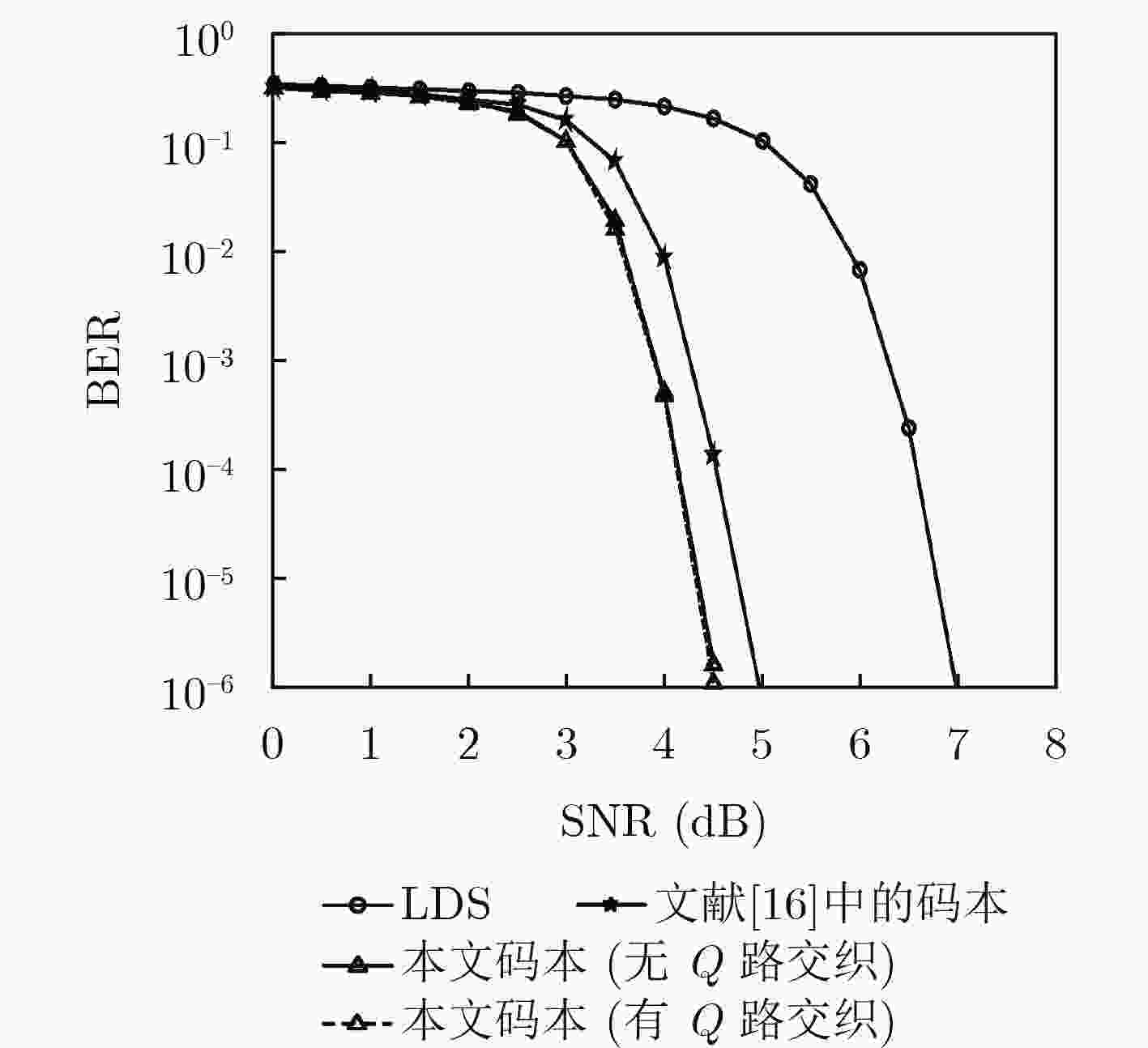Optimization Design Method for Sparse Code Multiple Access Codebooks
-
摘要:
稀疏码多址接入(SCMA)作为一种具有竞争力的非正交多址接入(NOMA)技术,该技术通过高维调制与稀疏扩频的结合,有效地提升了系统的频谱效率。该文针对现有SCMA码本设计中存在的问题,提出一种同时适用于高斯信道和瑞利衰落信道的SCMA码本优化设计方法。在该方法中,首先通过旋转基准星座和母星座,实现母星座在各个维度上投影点间的最小欧氏距离以及叠加在单个资源块上的总星座中与各用户对应的星座图上星座点间的最小欧氏距离的最大化,以提升SCMA码本在高斯信道下的性能;进而在保持总星座上星座点间最小欧氏距离不变的条件下,通过旋转叠加在单个资源块上多个用户的星座,优化叠加在单个资源块上的与各用户对应的星座图中星座点间最小乘积距离和信号空间分集(SSD)阶数,最后结合Q路坐标交织技术获得额外的分集增益,以提升系统抗信道衰落的能力。仿真结果显示:在高斯信道和瑞利衰落信道下,该文设计的SCMA码本的性能均明显优于华为公司提出的SCMA码本和低密度扩频多址接入(LDS-MA)技术。
Abstract:As a competitive Non-Orthogonal Multiple Access (NOMA) technique, Sparse Code Multiple Access (SCMA) improves efficiently the system spectral efficiency by combining the high dimensional modulation and sparse spread spectrum. To address the existing issues of SCMA codebook design, an optimization design method for SCMA codebooks is proposed for both Rayleigh fading and Gaussian channels. In the method, by rotating the base constellation and the mother constellation, the minimum Euclidean distance between the projection points of the mother constellation on each dimension, and between the constellation points on the constellations corresponding to each user in the total constellation on a single resource block is maximized in order to improve the performance of the SCMA codebooks over Gaussian channels; On the basis of it, by rotating the constellation of multiple users superimposed on each resource block, the corresponding minimum product distance and the Signal Space Diversity (SSD) order of the users’ constellations are optimized; At last, an additional diversity gain is achieved by using Q-coordinate interleaving technology to improve further the performance over the Rayleigh fading channels. Simulation results show that the performance of the proposed SCMA codebooks outperforms that of the HUAWEI’ SCMA codebooks and Low Density Signature Multiple Access (LDS-MA) in both the Gaussian channels and the Rayleigh fading channels.
-
表 1 仿真条件
信道 高斯信道和瑞利衰落信道 信道编码 1/3码率Turbo编码 帧长${L_{fr}}$ 1024 bit 帧数${N_{fr}}$ 300 译码算法 Max-log MPA Max-log MPA迭代次数 7 -
DING Zhiguo, LEI Xianfu, KARAGIANNIDIS G K, et al. A Survey on non-orthogonal multiple access for 5G networks: Research challenges and future trends[J]. IEEE Journal on Selected Areas in Communications, 2017, 35(10): 2181–2195. doi: 10.1109/JSAC.2017.2725519 HOSEIN N and BALIGH H. Sparse code multiple access[C]. IEEE International Symposium on Personal Indoor and Mobile Radio Communications, London, UK, 2013: 332–336. doi: 10.1109/PIMRC.2013.6666156. ZHANG Shunqing, XU Qiuqiang, LU Lei, et al. Sparse code multiple access: An energy efficient uplink approach for 5G wireless systems[C]. IEEE Global Communications Conference, Austin, USA, 2014: 4782–4787. doi: 10.1109/GLOCOM.2014.7037563. ZHANG Chenchen, LUO Yuan, and CHEN Yan. A low complexity SCMA detector based on discretization[J]. IEEE Transactions on Wireless Communications, 2018, 17(4): 2333–2345. doi: 10.1109/TWC.2018.2792425 MA Xinying, YANG Lin, CHEN Zhi, et al. Low complexity detection based on dynamic factor graph for SCMA systems[J]. IEEE Communications Letters, 2017, 21(12): 2666–2669. doi: 10.1109/LCOMM.2017.2752745 杜洋, 董彬虹, 王显俊, 等. 基于串行策略的SCMA多用户检测算法[J]. 电子与信息学报, 2016, 38(8): 1888–1893. doi: 10.11999/JEIT151259DU Yang, DONG Binhong, WANG Xianjun, et al. Multiuser detection scheme for SCMA systems based on serial strategy[J]. Journal of Electronics &Information Technology, 2016, 38(8): 1888–1893. doi: 10.11999/JEIT151259 FORNEY G K and WEI L F. Multidimensional constellations. I. Introduction, figures of merit, and generalized cross constellations[J]. IEEE Journal on Selected Areas in Communications, 1989, 7(6): 877–892. doi: 10.1109/49.29611 TAHERZADEH M, HOSEIN N, BAYESTEH A. et al. SCMA codebook design[C]. IEEE 80th Vehicular Technology Conference, Vancouver, USA, 2014: 1–5. doi: 10.1109/VTCFall.2014.6966170. BAO Jinchen, MA Zheng, MAHAMADU M A. et al. Spherical codes for SCMA codebook[C]. IEEE 83rd Vehicular Technology Conference, Nanjing, China, 2016: 1–5. doi: 10.1109/VTCSpring.2016.7504489. HAN Yu, WANG Zhenyong, LI Dezhi, et al. A novel multi-dimensional constellation design method based on lattices for sparse code multiple access[C]. IEEE 13th International Conference on Signal Processing, Chengdu, China, 2016: 1264–1269. doi: 10.1109/ISCP.2016.7878029. YU Lisu, LEI Xianfu, FAN Pingzhi, et al. An optimized design of SCMA codebook based on star-QAM signaling constellations[C]. International Conference on Wireless Communications & Signal Processing, Nanjing, China, 2015: 1–5. doi: 10.1109/WCSP. 2015.7341311. ALAM M and ZHANG Qi. Performance study of SCMA codebook design[C]. IEEE Wireless Communications and Networking Conference, San Francisco, USA, 2017: 1–5. doi: 10.1109/WCNC.2017.7925767. ALAM M and ZHANG Qi. Designing optimum mother constellation and codebooks for SCMA[C]. IEEE International Conference on Communications, Paris, France, 2017: 1–6. doi: 10.1109/ICC.2017.7996539. BOUTROS J and VITERBO E. Good lattice constellations for both Rayleigh fading and Gaussian channels[J]. IEEE Transactions on Information Theory, 1996, 42(2): 502–518. doi: 10.1109/18.485720 BOUTROS J and VITERBO E. Signal space diversity: A power- and bandwidth-efficient diversity technique for the Rayleigh fading channel[J]. IEEE Transactions on Information Theory, 1998, 44(4): 1453–1467. doi: 10.1109/18.681321 Altera Innovation Asia website, Presentation 1st 5G algorithm innovation competition-ENV1.0-SCMA[OL]. http://www.innov-ateasia.com/5g/en/gp2.html. 2017. BEEK J V D and POPOVIC B M. Multiple access with low-density signatures[C]. IEEE Global Telecommunications Conference, Honolulu, USA. 2009: 1–6. doi: 10.1109/GLOCOM.2009.5425243. -






 下载:
下载:














 下载:
下载:
